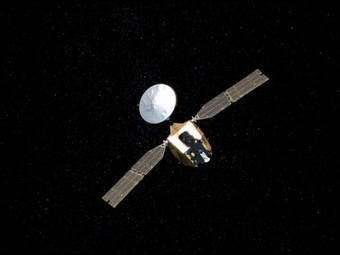Mars Reconnaissance Orbiter Mission Status

Three cameras on NASA's Mars Reconnaissance Orbiter worked as expected in a test pointing them at the moon and stars on Sept. 8.
Image: Artist's concept of Mars Reconnaissance Orbiter en route to Mars. Image credit: NASA/JPL
"We feel great about how the camera performed and can hardly wait to see what it will show us at Mars," said Dr. Alfred McEwen of the University of Arizona, Tucson, principal investigator for the High Resolution Imaging Science Experiment aboard Mars Reconnaissance Orbiter.
The test also checked operation of the spacecraft's Context Camera and Optical Navigation Camera, plus the spacecraft's high-gain antenna and systems for handling and distributing data from the instruments.
"The instruments and the ground data system passed this test with flying colors," said Mars Reconnaissance Orbiter Project Manager Jim Graf of NASA's Jet Propulsion Laboratory, Pasadena, Calif. "We received 75 gigabits of data in less than 24 hours, which is a new one-day record for any interplanetary mission."
The spacecraft was about 10 million kilometers (6 million miles) from the moon when it turned to slew the cameras' fields of view across that test target. At that distance, the moon would appear as a single star-like dot to the unaided eye. In the test images by the high-resolution camera, it is about 340 pixels in diameter and appears as a crescent about 60 pixels wide. The tests also included imaging of the star cluster Omega Centauri for data to use in calibrating the camera.
During its primary science mission at Mars, the spacecraft will orbit within about 300 kilometers (186 miles) of that planet's surface. From that distance, the high-resolution camera will discern objects as small as one meter or yard across.
The Mars Reconnaissance Orbiter, launched on Aug. 12, will reach Mars and enter orbit on about March 10, 2006. After gradually adjusting the shape of its orbit for half a year, it will begin its primary science phase in November 2006. The mission will examine Mars in unprecedented detail from low orbit, returning several times more data than all previous Mars missions combined. Scientists will use its instruments to gain a better understanding of the history and current distribution of Mars' water. By inspecting possible landing sites and by providing a high-data-rate relay, it will also support future missions that land on Mars.
More information about the mission, including new test images of the moon by the high-resolution camera, is available online at www.nasa.gov/mro
Source: NASA
















